Menu
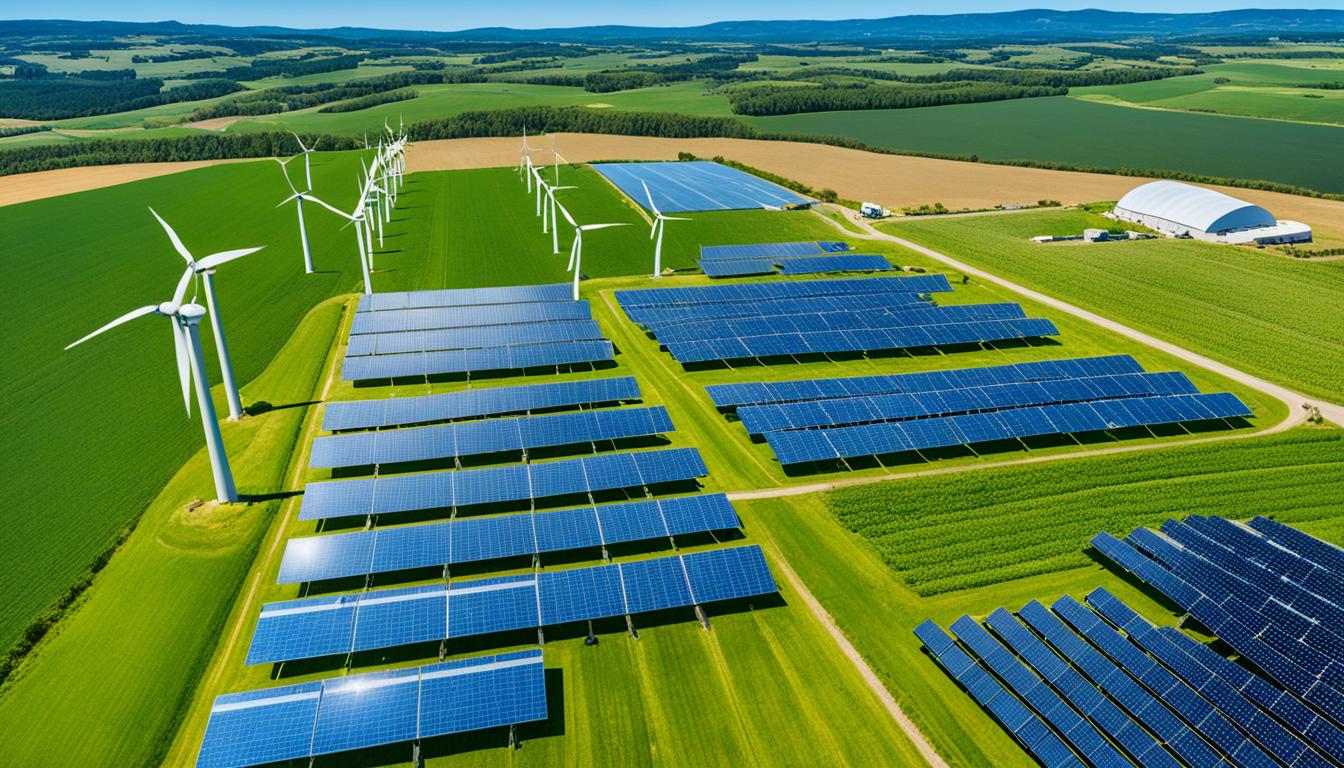
Did you know that 63% of dairy farmers see climate change as a big issue for their work? This high number shows how important it is to change farming to help the environment. Plus, 68% of agricultural land could face big problems due to climate change. This sounds the alarm for the need for smart rules to tackle these challenges.
This part looks at different examples where farms did well by the environment. We will see how these farm case studies worked with laws and still helped nature. Farmers from all over have found ways to run their farms well while taking care of the land. They show us it’s possible to have strong farm businesses and look after the environment at the same time.
Today, following environmental rules in farming is very important. This is because agriculture covers about 52 percent of U.S. land. So, it’s crucial that farmers update their methods to respect the environment.
In 2022, the value of farming lands was over $3.18 trillion. It makes up more than 80 percent of all U.S. farming assets. By caring for the land properly, we not only protect our surroundings but also keep these assets safe.
In the past 30 years, about 40 percent of U.S. farming land has been rented. In 2014, non-farming owners held 31 percent of these lands. This shows how varied interests make following environmental rules challenging.
After World War II, farming became more productive. This was due to new tech, machines, more chemicals, and specialising. But, it had a serious environmental downside. This led to calls for more sustainable farming over the last 40 years.
Sustainable farming aims for a healthy environment, making money, and being fair to everyone. It’s about meeting today’s needs without damaging the future. With the world’s population expected to hit 9.7 billion by 2050, we must switch to sustainable ways of farming – it’s crucial, not just a choice.
“Resilience, adaptability, and diversity are fundamental components for the longevity of agroecosystems.”
Farming boosts the economy, fights poverty, and feeds people worldwide. But, it strains the planet and its resources, made worse by climate change. This is why following environmental rules is key. It helps lessen agriculture’s harmful impact while guiding it towards sustainability.
Across the globe, governments, scientists, farmers, and NGOs are working together. They aim to reshape our farming and food systems for the better. This unity is vital for following environmental rules and ensuring our farming future is resilient and sustainable.
Looking at farming as a range from harmful to very sustainable is more helpful than a black-or-white view. Sustainable farming is an ever-changing idea shaped by today’s challenges. It’s about finding a good balance between farming and protecting the natural world. Keeping the focus on sustainable farming practices offers a way to make agriculture less damaging. It also secures a stronger future for farming.
| Aspect | Details |
|---|---|
| U.S. Land Utilisation | 52% |
| Farm Real Estate Value (2022) | $3.18 trillion |
| Farmland Rented Out (Last 30 Years) | 40% |
| Non-Operator Landlord Holding (2014) | 31% |
The impact of environmental rules on farming brings to light a rich history. The Dust Bowl era stands out as a key period. It was in the 1930s when severe drought hit the Plains. Areas like southeast Colorado were hit hard.
During this time, regional dust storms spiked then dropped by 1940. This wasn’t just due to climate changes. It was also because of how people farmed the land.
Between 1925 and 1930, 33 million acres were left bare by farming methods. A severe drought classification, D4 (Exceptional Drought), remains common in many areas. This shows that tough environmental issues need smart farming solutions.
The government stepped in to help, offering a dollar per acre for farmers to try new methods. This included crop rotation and terracing. These techniques aimed to protect the soil and farm more sustainably.
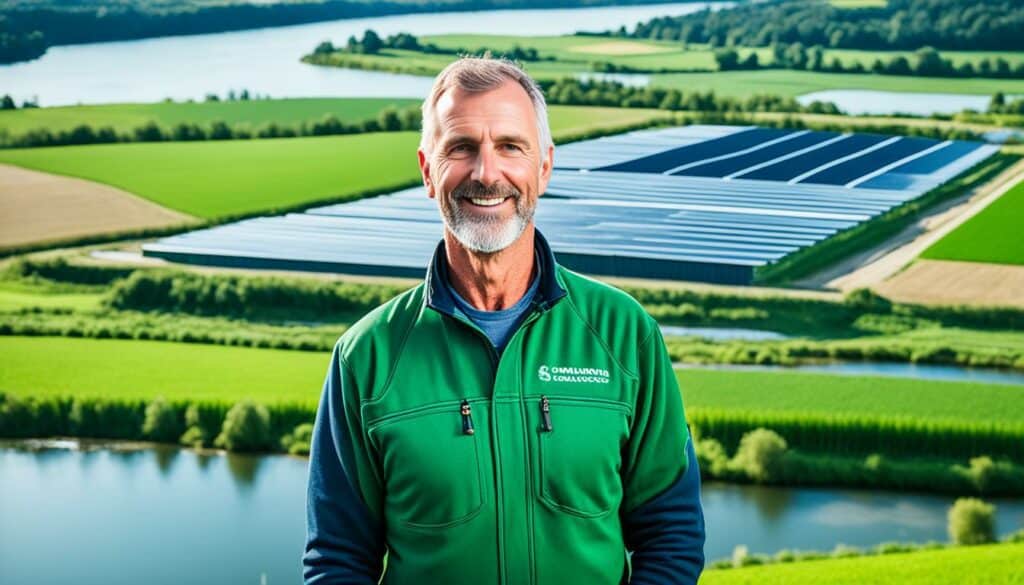
The Civilian Conservation Corps was key in planting 200 million trees, from Canada to Texas, to break the wind. This helped save soil and dealt a blow to severe drought. The drought of 2012, although much later, also severely impacted crops. It underlined why solid farming laws are necessary for the future.
After World War II, we saw a big increase in food and fibre output. New tech, machines, and more chemicals played a part. But this growth came at an environmental cost.
In the last 40 years, we’ve seen serious issues like topsoil loss and pollution. This has made strict farming regulations even more important.
The focus now is on farming that’s good for the environment, makes money, and is fair. Looking at the past, we see a clear move towards caring for our resources for the long term. This approach highlights the need for everyone involved in farming to work together.
As we move forward, the lessons we’ve learned from the past continue to guide us. We see how environmental rules shape farming and encourage sustainability.
Sustainable farming is vital for both the future of agriculture and our planet’s health. After World War II, technology, mechanisation, and more chemicals increased food and fibre output. However, this growth harmed the environment. This sparked a need for farming to become more sustainable.
Sustainable farming focuses on three key aims – keeping the environment healthy, making money, and being fair to everyone. Over the past 40 years, people have supported sustainable farming more and more. It’s seen as critical for current food systems. This method protects nature and resources for the future.
Sustainable agriculture integrates three main objectives: a healthy environment, economic profitability, and social and economic equity.
This farming approach looks at the environment, social issues, and the economy equally. This balance helps farm systems be strong and able to change. All kinds of farming, from small fields to worldwide food networks, show us how well we’re doing sustainability-wise.
For farming to be successful in the long run, it needs to be flexible, diverse, and tough. These qualities help in facing different problems. Working together in studies, teaching, and practical steps can make farming more sustainable. This shows that farming sustainably is a responsive idea, adapting to new needs and thoughts.
| Key Elements | Details |
|---|---|
| Environmental Health | Emphasis on promoting soil health, minimising water use, and reducing pollution levels |
| Economic Profitability | Ensuring sustainable farming operations are economically viable |
| Social Equity | Providing equal opportunities for farmers, labourers, consumers, and policymakers |
Looking after the environment in farming also means tackling water pollution. Issues like soil salinisation and harmful chemicals affect the water. Sustainable agriculture works to fix these problems in our food chain.
The Bec-Hellouin Farm in Normandy is a brilliant example of regenerative agriculture. It uses permaculture designs to blend farming with nature. This approach has become a popular model for farming in harmony with the environment.
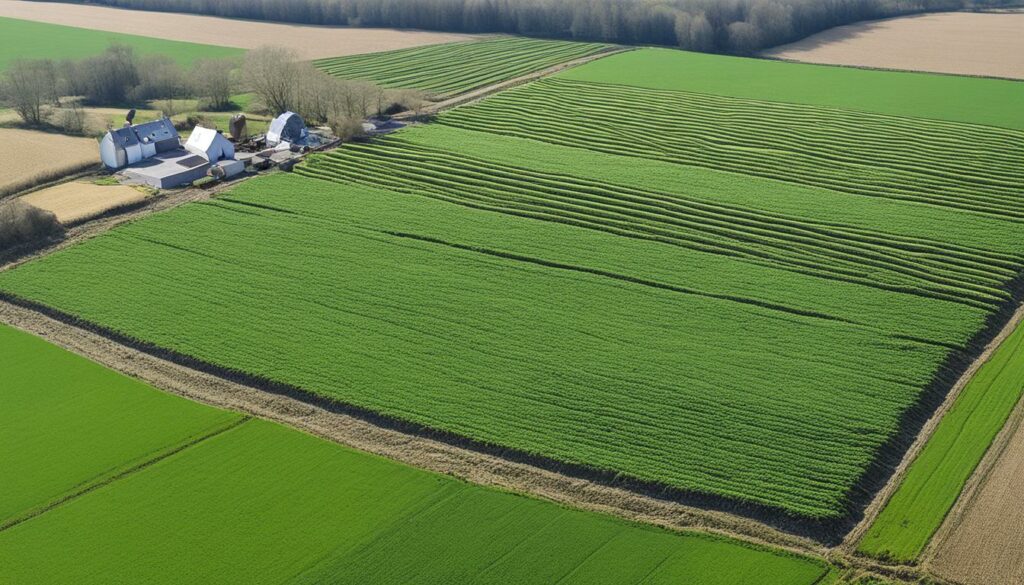
Bec-Hellouin focuses on farming methods that heal the land and support local ecosystems. Between 2011 and 2015, studies showed their way of farming is both eco-friendly and highly productive. They achieved ten times more yield than traditional organic farms using machines. Today, 80% of similar projects in France follow the farm’s lead. This shows the impact it has had on the agricultural community.
The farm’s success is not just in its methods but also economically. In a single year, their sales grew from €33,000 to €57,000. This rise in income proves that ecological farming can be profitable. Farm income ranged from €1,337 to €1,571 each month in 2014. This was with the farmers working an average of 43 hours each week—a good balance of work and earnings.
| Metric | 2013 | 2014 |
|---|---|---|
| Gross Sales (€) | 33,000 | 57,000 |
| Working Hours | 2,006 | 3,026 |
| Net Monthly Income (€) | N/A | 1,337 – 1,571 |
All this success proves the farm’s approach works well for both the planet and the pocket. By balancing production efficiency with labour needs, they’ve shown a sustainable way to farm. This model benefits the economy, the ecology, and the people working the land. It’s truly a win-win situation.
Many factors play into how well we adapt to green rules. Environmental policy in agriculture sets the stage for eco-friendly farming. This impacts everyone from local farmers to the big food market.
Working closely with farmers helps get more nature-friendly practices into action. A study by Kalcic et al. proved that letting farmers decide leads to better results. Findings by Baumgart-Getz et al. show that in the US, 17% to 25% of farmers started using the best methods.
Farmers’ education level is another key factor. The better they understand, the more they can do. Strong farmer education, backed with financial help like USDA’s $5 million to cut Lake Erie pollution, is vital for success.
Flexibility in farming is also crucial. Being able to change methods when needed is important. Research in China and by Pannell et al. shows that adaptable farmers do better with green rules.
Looking at nitrogen in New Zealand and pollution in China, we see the need for custom-made solutions. Each place has different pollution levels, so strategies must be localised to work well.
| Study/Statistic | Key Findings |
|---|---|
| New Zealand Coastal Catchments | Nitrogen yields reported at 1039-1052 |
| China Non-Point Source Pollution | Assessment results between 1159-1168 |
| USDA Lake Erie Runoff | $5 million commitment to reduce runoff |
| US Adoption of Best Practices | 17% to 25% adoption rate |
| Conservation Agriculture Economics | Profitability ranges from 52% to 64% |
To create successful green strategies, we must understand many influences. With the world needing more food and facing serious challenges, smart farming is crucial. Education, policy, and the ability to change will guide farming to a greener, sustainable future.
In the past 30 years, northern Ghana has faced worse climate change issues. These have made life hard for farmers. They have to deal with both changes in weather and other difficulties. The whole world is facing more extreme weather because of climate change. This leads to big losses for farmers. Knowing what problems farmers face is key to helping them adapt.
Farmers in northern Ghana are trying new crops and getting help to be more resilient. But, they often can’t make progress because of certain problems. These include bad coordination between policies and groups, different people’s goals, and not having enough money. These make it hard for farmers to follow environmental rules and to change their farming in ways that help the planet.
There are two ways farmers can adapt well. One is a bit by bit change, which helps in the short term. The other is making big changes for the future. Both ways need to be fair and good for the community. This is the best way to make sure everyone benefits and farming can keep going strong.
In the Upper West Region of Ghana, farmers have found new ways to farm better. They use modern tools in farming. This has made big farms work better. But, small farmers still struggle a lot. They have money problems and it’s hard to sell their crops. Also, they don’t always have the best roads to bring or sell their crop.
It’s not just in Ghana where farmers face these challenges. In the US, many small farms also have a hard time. They make less money than bigger farms. They also need money to buy new farming tech. This makes adapting to changes very difficult for them.
To really help farmers, we need strong policies and groups that work together well. We have to understand the mix of problems made by the climate and other things. This way, we can help farmers in a way that is fair, and helps everyone including the planet. This is how we make sure farming can keep going even as the climate changes.
When we look at how farms adapt, we see two main ways: incremental and transformational. Each way changes farming differently.
Incremental adaptation means making small changes to farming. This is done to make the farm stronger but without big changes. In Northern Ghana, farmers might change the types of crops they grow or when they plant them, or they might work on making their soil better.
But making small changes can sometimes cause new problems. For example, using more chemicals to protect crops might hurt the soil in the long run. This could make the environment worse.
Transformational adaptation is very different. It’s about making big, new farming systems. These are needed for dealing with big problems like climate change. Big changes can help protect farms for a long time.
People around the world have had to move to new ways of farming. This change is not easy and comes with risks. It can mean losing old ways of life and knowledge. This change is hard on the heart of a community.
Studies show that places with big climate problems often need to make these big changes. But places where farming has always been more stable might use smaller steps.
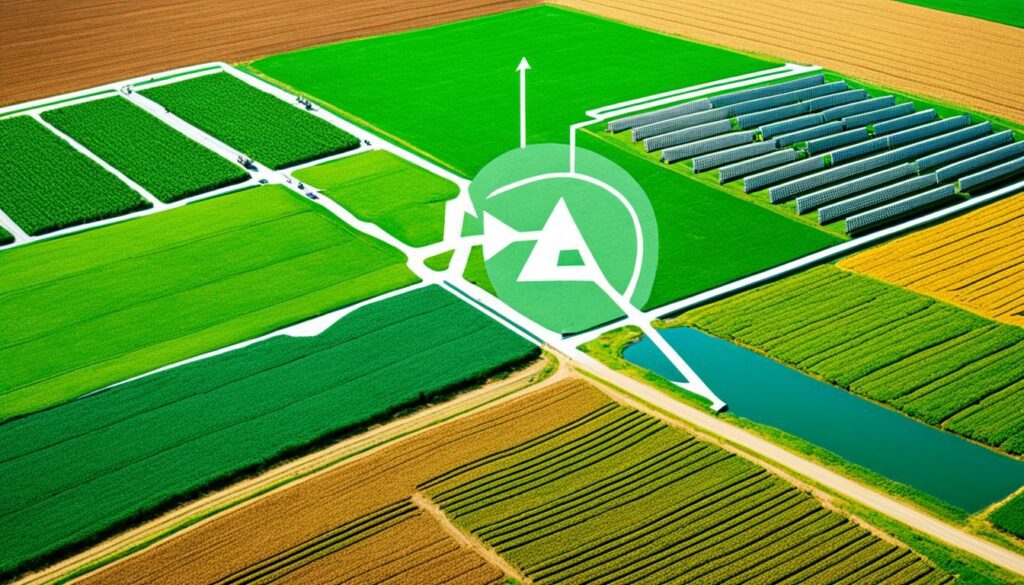
Indigenous people and locals look after a lot of the world’s farming land. Making sure their ways are part of big plans is very important. It helps keep the land healthy and supports their way of life.
| Adaptation Strategy | Characteristics | Potential Adverse Impacts |
|---|---|---|
| Incremental | Minor adjustments to existing practices | Potential soil degradation, pollution |
| Transformational | Fundamental changes, creating new systems | Loss of traditional values, identity |
When choosing how to change farms, we should think about the effect and our long-term goals. Knowing the right way to change is key to fighting climate change in farming.
Climate change is causing more droughts and floods, especially in places like Northern Ghana. These events are making farming very hard. But, people are finding good ways to deal with these challenges.
In Bagri, a village in Northern Ghana, life is tough because of the changing climate. Many groups, like the Dagara and the Hausa, farm to survive. But, they lack things like electricity and places to store food, which makes the problem worse.
Some creative solutions are making life better. The Great Green Wall project plants trees to stop deserts from growing. This also helps the land keep water. In Bhutan, they use natural methods to fight water shortage, showing local ways can beat big problems.
Farmers are using smart methods to fight the bad effects of drought and floods. They dig zai pits to save water and grow different crops to cope with the changing weather. In Rotterdam, new ideas mixed with old wisdom are helping a lot too.
Building up local ability to deal with drought is also key. In Colombia and Ecuador, they are making food security strong, so people don’t go hungry even with bad weather. This helps keep farms running.
Good policies are big helpers too. In Haiti, farmers get insurance against crop loss from bad weather. This helps them take risks to do farming in a better, safer way.
All these examples show how important it is to have the right tools and help to fight climate challenges. With the right farming ideas and support, we can beat drought and keep farming going strong for a long time.
I follow the latest in farming closely. It’s clear that the right practices are vital for the environment. Using farming methods that match our green goals helps both our harvests and nature.
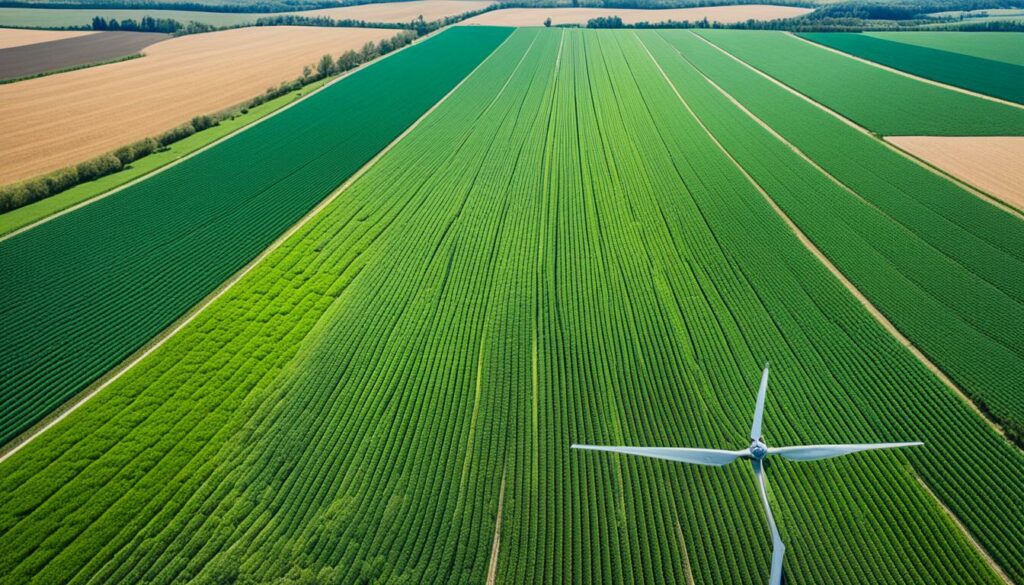
In Switzerland, about 32% of farms follow good practices well. This figure is a bit higher in the US, at 40%. It shows that farmers worldwide are working hard to be eco-friendly.
Landscape management is better with a mindful eye on nature. Leaving some fields untouched helps wildlife. And organic farming is on the rise. It cuts back on harmful chemicals and boosts sustainable farming.
Seeing how farming affects the planet is key. In the US, big money goes to greener farming. Millions are spent to support practices like crop rotation. Such steps keep our soils healthy.
| Region | Compliance Rate | Investment in Sustainable Practices (USD Million) |
|---|---|---|
| Switzerland | 32% | NA |
| United States | 40% | USD 2,000 |
The CAP aims for farms to be net-zero on harmful gases by 2050. China has laws to protect water and soil. These efforts around the world show a push for a green future.
New rules based on science are helping farm better and smarter. They help to save land and water, and find new, eco-friendly tech. The CAP links money to helping the environment, making a win-win.
By using these tips, farmers not only follow rules but also do better for nature. This helps farms to be stronger against the changing climate.
The importance of policy support in farming is huge. In our changing world, strong rules and systems are key. They help farmers adjust well, making sustainable farming possible.
Keeping up with policies is vital for farmers to go green. For example, rules from the Clean Air Act and studies by Berry et al. show us why. They protect our land and animals from climate harm, pushing for smart changes.
Everywhere, farmers are changing due to climate swings. Howden et al.’s studies prove we need good policies. They’re like a guide, helping farmers update methods as weather changes. The IPCC also says smart policies are crucial for fighting climate issues.
Institutional frameworks offer continuous help for farmers. They help spread knowledge and provide training. Lal et al. (2011) say these supports are key for making changes happen. They connect policy plans with what happens in real fields.
Mixing strong policies with supportive frameworks is critical for lasting success. As the World Economic Forum warns, failing to act on climate is a huge risk. Plus, feeding more people by 2050 demands better farming, fast. Good rules and aid for farmers are a must.
In the end, solid policies and supportive frameworks lead the way for farming. By helping farmers adapt, we ensure agriculture’s future. It’s all about setting the stage for successful changes.
Climate change brings big risks for our world’s development. It affects both rich and poor countries, putting millions at risk. Community adaptation strategies and collective farming initiatives are key to facing these dangers. They help protect communities who rely on nature.
It’s important to help those who are often overlooked. Working with local people to adapt helps make stronger communities. It’s vital to share knowledge within communities to tackle problems like hurricanes and wildfires.
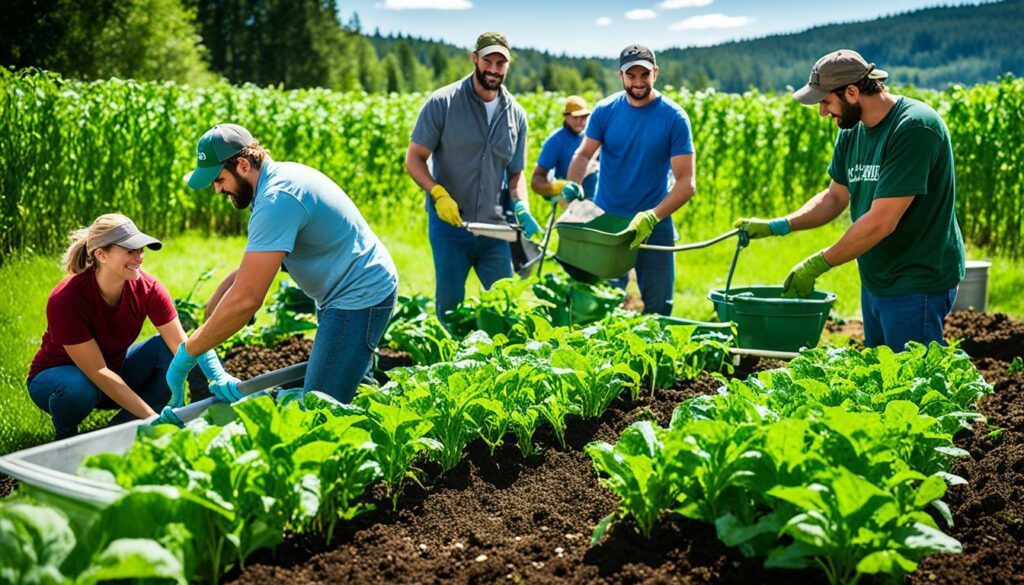
We must understand why community adaptation strategies are so important. By 2025, low-income countries may not have enough food. Climate change could make 35 to 122 million more people very poor by 2030. To really make a difference, we need to move from short-term plans to long-lasting, local solutions.
| Key Statistic | Value | Relevance to Strategy |
|---|---|---|
| Projected food deficit in low-income countries | By 2025 | Community-based adaptation necessary to mitigate risks. |
| Additional people pushed into extreme poverty by 2030 | 35 to 122 million | Emphasis on local and community adaptation strategies critical. |
| Households included in adaptation study | 335 | Community-based data crucial for strategy formulation. |
| Wildfire damages in Australia (2019-2020) | Devastating | Highlighting the need for collective farming initiatives. |
| Hurricane damages in the U.S. | USD 200 billion | Significance of integrated adaptation efforts. |
The modern agricultural sector is making big leaps thanks to technology. It’s helping farms meet the changing rules for sustainable farming. Better crops and irrigation methods are key. They help farms follow the rules better and produce more.
Farming technology has given us crops that do more. They can fight off bugs, handle dry spells, and give bigger harvests. An OECD report shows that these special crops have made farms 25% more able to adapt. They help farms follow the rules and make more money too.
New ways to water crops are just as important. They’re needed more than ever with climate change. A study by Hatfield et al. found that bad weather can cut harvests by 22%. Smart irrigation cuts water use, helping farms meet green goals.
| Technology | Impact | Adoption Rate |
|---|---|---|
| Improved Crop Varieties | Higher yield, pest resistance | 25% increase |
| Advanced Irrigation Systems | Water conservation, efficiency | High Adoption |
Using better crops and new ways to water is making farming stronger. These tech upgrades are key for farms. They help follow the rules and do well in any weather.
Environmental rules are key for farming that looks to the future. But they’re tough on smaller farms. A study in China looked at this between 2012 and 2018. It checked 17 different things in 34 areas.

The research had four main points to look at. It found that these rules help farming grow better. This is a good thing. But, those rules are harder for small farms. Big farms can handle them better because they have more land. This makes things harder for smaller farmers who don’t own a lot of land.
Since 1993, China has had a law to fight farm pollution. This law is great for the long run, but it makes things tough for small farmers now. They find it hard to make enough money when they follow the rules.
There’s also not enough resources for farming. And too many farms are using up the land. All this makes it hard to earn money from farming. In the U.S., changes in help for farmers show similar stories. More help meant more land was safe to farm. This really changed the money side of things.
| Period | Insured Acreage (Millions) | Additional Factors |
|---|---|---|
| 1990-94 | 90 | Initial Premium Subsidies |
| 1995-99 | 197 | Increased Participations |
| 2000-03 | 212 | Average of Cultivated Cropland |
To make things better, we need smart rules. These should help small farms and protect nature. This way, both farmers and our planet can do well for a long time.
Sustainable farming is changing the game in agriculture today. It’s all about using new techniques to grow crops better. These methods make farming more efficient, cutting costs and bringing big benefits.
One big plus of sustainable farming is how it boosts what farms can produce while cutting costs. Agriculture has really changed since World War II. Now, fewer farmers make more food and clothes for us, but they cost less. Using methods like drip irrigation, studies found they can use 20-40% less water. And they see their crops grow by 20-50%. This means less money spent on water and fuel, and more profit for farmers.
Sustainable farming also helps the ground and the life that lives in it. Things like cover crops and farming without tilling help keep the soil from washing away. They also add stuff to it, keep it wet, and make it stronger. Making the ground and everything that lives there tougher helps them survive all kinds of weather. Strong, varied soil supports many plants, making farming healthier and sustainable for the long run.
Sustainable farming is all about taking care of our planet and people. It makes sure we get what we need from farms now and later. By looking after the soil and using less, farmers can have farms that work well and keep going strong.
Farmers around the world are now focusing on environmental laws. They are adapting to stay in line with these regulations. Thanks to a 2018 USDA NRCS Conservation Innovation Grant, we have some great case studies. They show how farmers are making it work.
The AFT worked with farmers to create detailed case studies on soil health. These studies show the success that ‘soil health successful farmers’ had. They look at the costs and benefits of good soil health practices.
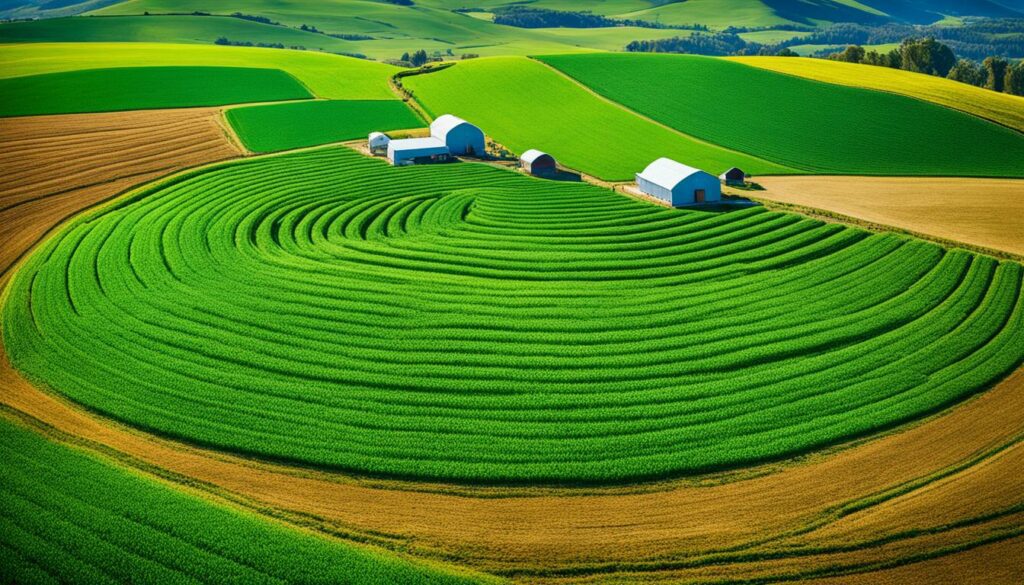
Producers talked about their experiences using special tools. AFT’s tools, like the R-SHEC questionnaire and Excel, gathered specific data. NRCS experts and soil health specialists checked these case studies. So, we know the findings are solid.
AFT started using data from the Cornell DFBS survey in 2022. This includes info from farms like Mulligan Farm and Table Rock Farm in New York. The idea is to do more studies, especially on dairy farms. This data helps understand how soil health affects money matters in places like California, Idaho, and New York.
Take Union Farms in Nebraska as an example. They’re a medium-sized family farm but they’re big on success. They show how other pork producers can make extra money. Union Farms earns $10 to $15 more per ton of carbon, thanks to carbon credits. They carefully track their farming processes using GS1 Standards.
GS1 Standards also help in determining the carbon impact of pork production. A special standard, EPCIS 2.0, is used by Union Farms. It tracks the carbon impact of their pork, from planting crops to selling pork. This makes sure the info about their pork’s impact is accurate for customers.
Today, over 300,000 businesses in 25 industries trust GS1 Standards. These businesses use the standards for a reliable supply chain. They help with keeping track of products and making sure farms follow environmental rules.
These stories about successful farming are very important. They show how to meet environmental rules and still do well. They motivate others to follow in their steps. This encourages both farmers and those who make the rules to keep farming in ways that protect our planet.
The journey of adapting agriculture has showed us a lot. It has taught us how we can overcome the challenges from climate change and new environmental rules. This knowledge, gathered from around the world, helps us understand how to face these challenges better in the future.
In 2013, vital recommendations were made on adapting agriculture to a changing climate by the 25x’25 Adaptation Initiative. This was helped by a study in 2012 by Barnes and Toma, showing the different ways dairy farmers adapt to climate change. Together, these studies help us see the variety of ways farmers have faced climate challenges.
Many studies, including work by Beddington et al. (2012) and Hatfield et al. (2011), have looked at how to keep food safe from climate change and how it affects crop growth. They underline the importance of having clear plans on how to deal with the change we’re making to climate.
Lobell et al.’s study in 2013 highlighted one interesting way to look at climate adaptation in farming. They showed how adapting to climate change can also help slow down further climate change. Studies like these and opinions from industry bodies stress the importance of acting now on climate change and following new rules.
| Source | Key Contribution |
|---|---|
| 25x’25 Adaptation Initiative (2013) | Recommendations for adapting farming to climate change |
| Barnes and Toma (2012) | Typology of dairy farmer perceptions towards climate change |
| Beddington et al. (2012) | Challenges and opportunities in achieving food security |
| Hatfield et al. (2011) | Implications of climate impacts on agriculture |
| Lal et al. (2011) | Management strategies for climate change mitigation |
| Lobell et al. (2013) | Adaptation as a form of mitigation |
Learning from adaptation experiences, projects across the globe are showing us valuable lessons. For example, projects in Egypt and Cambodia highlight the strength in agricultural cooperatives and good communication. These lessons are key for making agricultural practices better in the future.
The Adaptation Fund has been monitoring projects in various countries since 2012. Lessons from these projects focus on engaging people and finding solutions that can be used in many places. For example, work in Honduras and Nicaragua stress the importance of involving and training young people in these projects.
These global farming lessons are a treasure trove of valuable information. They highlight various experiences to help us focus on what’s important. By following these lessons, we can make agriculture more sustainable.
Encouraging farming to adapt is crucial with climate change’s global effects. In Alaska, higher temperatures have brought both benefits and difficulties for farmers. This shift means more chances to grow crops but also more challenges from invasive species and diseases. So, planning for the future is key to keep farming sustainable.
The “Adaptation Resources for Agriculture” workbook is a great tool for farmers. It helps them set goals, understand climate impacts, pick the best ways to adapt, and check their progress. The book also tells how Alaska’s farmers have made their farms more resilient against climate change.
A good example from the workbook is the work at the University of Alaska-Fairbanks. They focus on managing soil well, using compost, and making sure the soil is healthy. These steps are important for strong future farm plans.
USDA support is vital, with its help for farmers to deal with climate change. This aid is key to getting ready for extreme weather and lessening climate risks, which experts point out as a major global problem.
Farmers need to prepare by doing things like planting different crops or following new trends in food markets. Nationally, governments must make policies that help local farmers adapt to climate change’s strains effectively.
Studies around the world give clues to effective ways to prepare for the future in farming. They cover areas from Europe to the US, Canada, and beyond. Yet, there’s still much we don’t know about how to best adapt our farming – from small to large scales.
| Region | Main Adaptation Strategies | Challenges Faced |
|---|---|---|
| Alaska | Soil Management, Composting, Pest Control | Invasive Species, Pests, Diseases |
| USA | Improved Crop Varieties, Advanced Irrigation | Extreme Weather Events |
| Developing Countries | Farmer Education, Community Initiatives | Resource Scarcity, Economic Constraints |
In conclusion, working together, supporting good policies, and finding new, smart ways to farm are essential. Learning from each other’s successes can help us all make stronger and more sustainable farming for the future against climate threats.
In wrapping up our look at how farming and environmental laws interact, we see that fitting into these laws is key to farming’s future. Stories and facts from this article show how farmers worldwide have changed their ways to help the planet. We’ve seen how farming first turned big and industrial, and then started to focus on being careful in the European Union. Throughout, there have been tough times but also big steps forward.
Between 1965–1966 and 1998–1999, the amount of food grains made each year went up a lot. This happened because farmers used new seeds and more water to grow crops. It shows that we can produce more food while still being kind to the environment. Places like Punjab and Haryana in India have shown how farming can be good for food and nature at the same time.
Yet, some people worry about new farming technologies like GMOs and using antibiotics in animal food. They say we need to keep watching and be ready to change how we farm. For example, the gases that come from Indian soils and the fertilisers we use are a big deal for the environment. A meeting in Wageningen talked about using new tech for farming that’s friendly to nature. It reminds us that everyone needs to work together to make farming better for the Earth.
To sum up, the way farms follow rules and change shows a worldwide push for better farming. This means always looking for new ideas, helping by making good laws, and working with the people around us. Learning from these efforts is crucial as we aim for farming that both makes lots of food and cares for the environment. Let’s keep going, using these examples to keep making farming greener and stronger.
Environmental rules are key to farming in a way that keeps nature safe. They help lessen harm, save nature, and keep a balance in farms.
Following regulations helps avoid fines and helps farm sustainably. This, in turn, means healthier soil, more crops, and less spending over time.
Laws and environmental movements have shaped these rules over time. They aim to meet new eco-needs and to keep farming eco-friendly.
Sustainable methods are key for taking care of the environment. They help in many ways, like fighting climate change and saving wildlife, to keep farming possible in the long run.
Bec-Hellouin Farm uses permaculture to grow food and protect the planet. This means plants are grown in a way that helps farms and nature. They rotate crops, grow trees with crops, and use no harmful chemicals.
Farmer knowledge and laws that support eco-friendly farming are key. Being able to change how they farm is important too.
Challenges are weather problems like droughts, money worries, and the lack of new farming tools.
Incremental change is small tweaks, but transformative change is big, system-wide shifts. Both are used to tackle different farming and eco-problems.
They’ve started using crops that survive droughts and better ways to water fields. This helps them against tough weather.
Using resources wisely, cutting down on chemicals, and farming with nature in mind are top practices. Monitoring farms closely also helps.
Good rules and strong organisations help farmers know what to do. They also give them tools and reasons to farm in a green way.
Working together can teach farmers new things and help them make big changes. It’s a powerful way to face farming challenges.
New crops and better ways to water fields help farmers do more with less. This makes it easier to follow the rules and farm well.
At first, following the rules might cost more. But in time, farmers manage resources better, grow more, and get help. This helps small farms stay strong.
Using sustainable farming means more crops, lower costs, and better soil. It also helps nature thrive. This makes farming last for years to come.
Around the world, farmers show that new, tough ways of farming work. They have found ways to meet the green farming rules well.
We’ve learned that being ready to change, having help from laws, working together, and using new tech can make farming greener and stronger.
New rules, more research, teamwork, and showing good examples can help farmers learn and farm better. This grows a farming that’s kind to the earth.